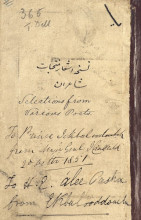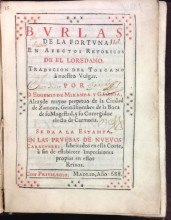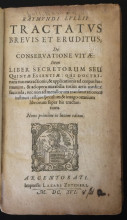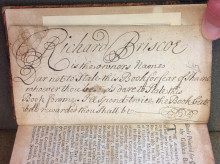Pablo Alvarez
Posts tagged with marks of ownership
Showing 1 - 7 of 7 items
![Spine and front cover of Gulielmus Durandus (ca. 1230-1296) et alii. [Tractatus varii] Paper. Germany 15th c.](/sites/default/files/styles/medium/public/chainbinding.jpg?itok=jTMtwzS6)
We are pleased to announce the launching of our most recent Omeka exhibit: Marks in Books. In this online exhibit, the term "marks" refers to physical elements that have been added to manuscripts and early printed books throughout time, that is, from the instance when they were being made until they arrived to our shelves. Mostly, these marks were not intended by the authors, scribes and printers as they originally envisioned their books, but were later included in the form of corrections, readers' marginalia, drawings, and traces of subsequent ownerships as shown in bookplates and bindings. These marks are extraordinary witnesses offering unique information on various aspects of book history such as production, textual transmission, reception, and provenance history.

The manuscript currently preserved in our library under the shelfmark Isl. Ms. 350 has a fascinating history that can be traced in internal owners’ marks and external documentary sources. Produced in Delhi, the manuscript was acquired by the library in 1924 along with several hundred other manuscripts from Istanbul that came to be known as the "Abdul Hamid Collection." How did the manuscript end up in Istanbul? Read the intriguing story in this first of two posts!

In a previous post, I argued that we must judge a book by its cover because the design of an early binding can tell us much about the social status of its former owner. Now, I would like to argue that we can learn a lot about early printing history by examining the preliminary pages of a book.

'Sammelband' is a German term meaning 'anthology', which, in a general sense, bibliographers often employ to describe a bound volume that contains a group of separately published works. Our featured sammelband volume also includes handwritten inscriptions revealing a fascinating provenance story.
![Arthur Dee (1578-1651). Fasciculus chemicus, abstrusae hermeticae scientiae, ingressum, progressum, coronidem, verbis apertissimis explicans [Paris: 1631]](/sites/default/files/styles/medium/public/img_0688.jpg?itok=PrvvVdZE)
Shortly after I completed a blog post arguing that the Special Collections Library holds a book formerly owned by Isaac Newton, another one has just resurfaced from the Le Roy Crummer Collection, part of our rich holdings in the history of medicine.

Here is a fascinating story of how we learned that the Special Collections Library holds a volume formerly owned by one of the most important figures in the history of science, Isaac Newton.

Rhymes that identify book owners, warn or threaten book thieves, and extol the virtues of learning appear in interesting variations, particularly on the pages of eighteenth- and nineteenth-century school books.